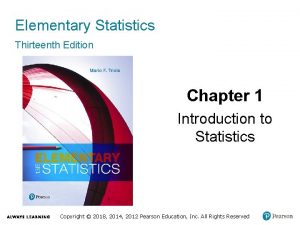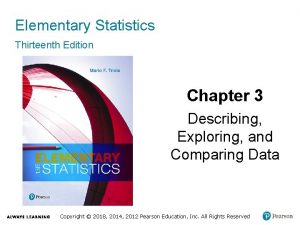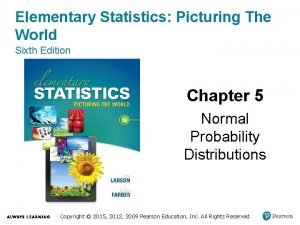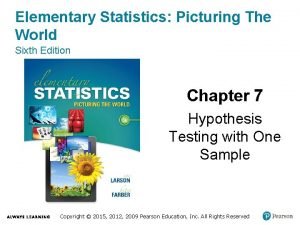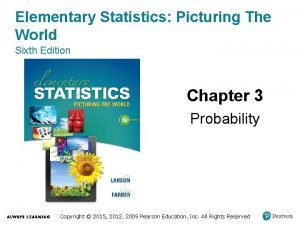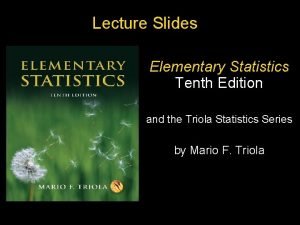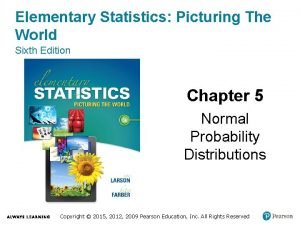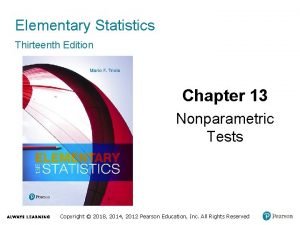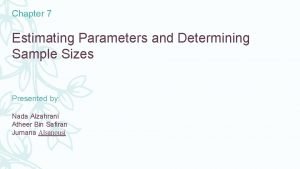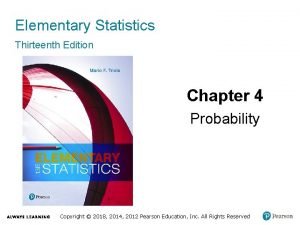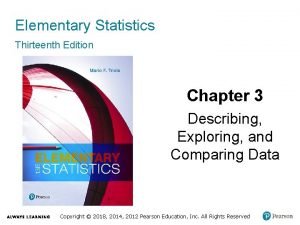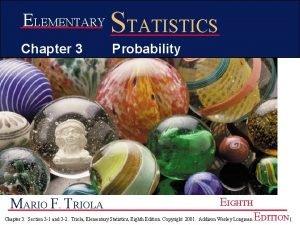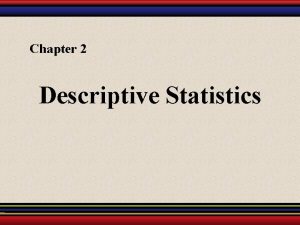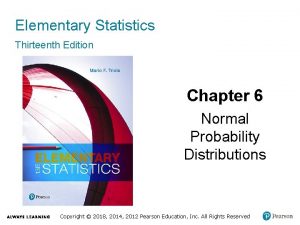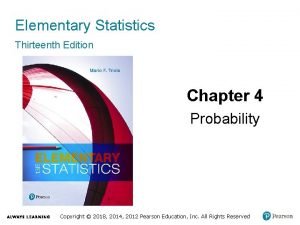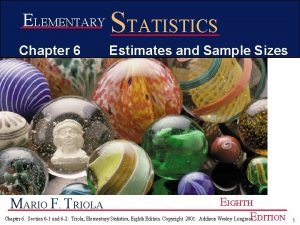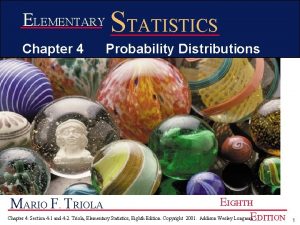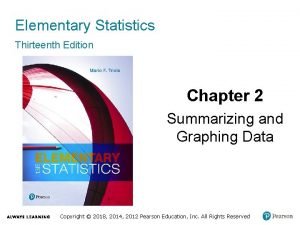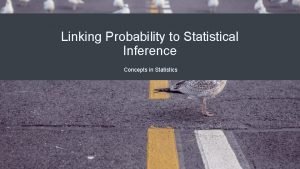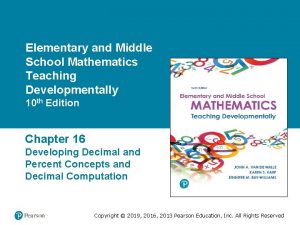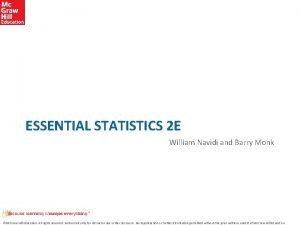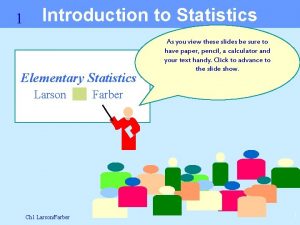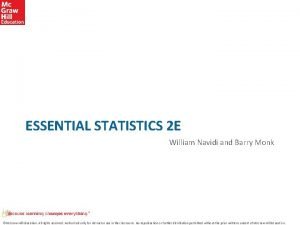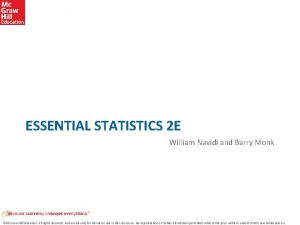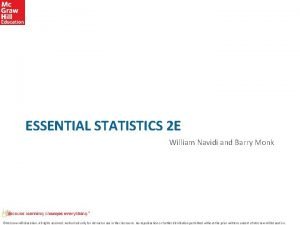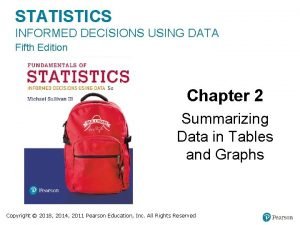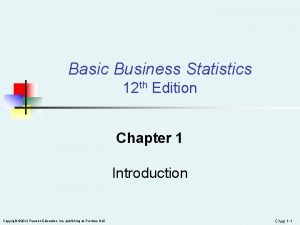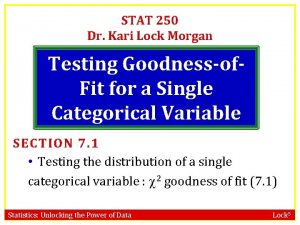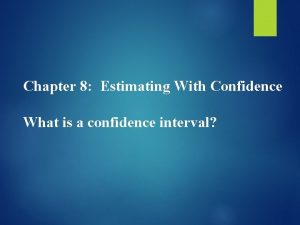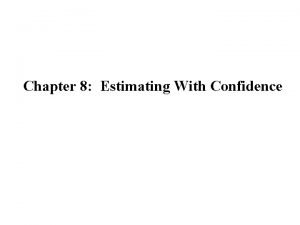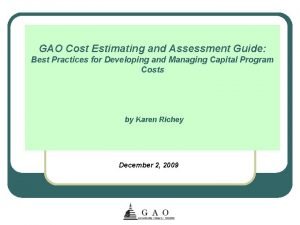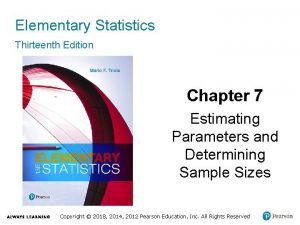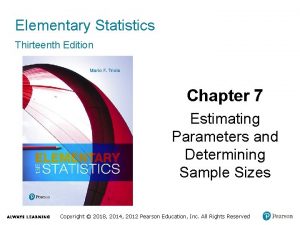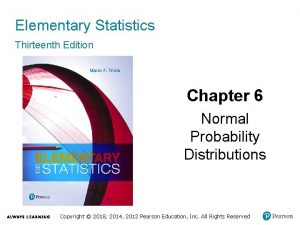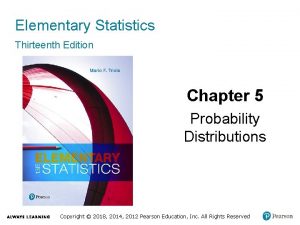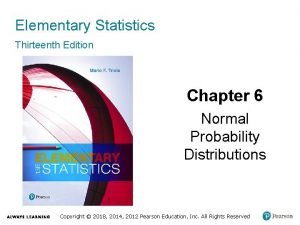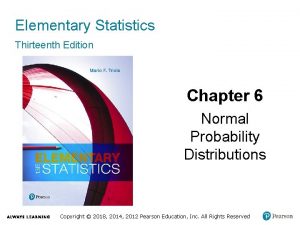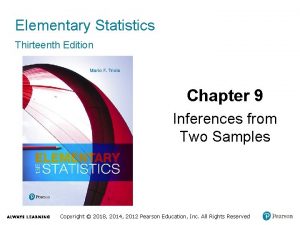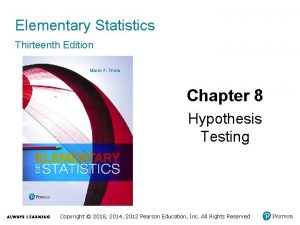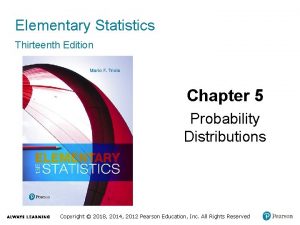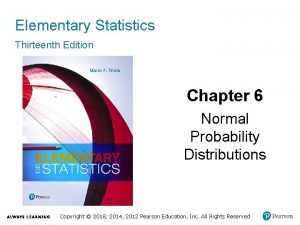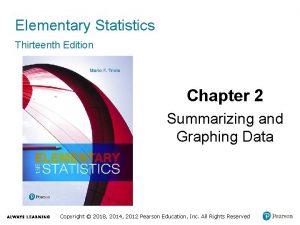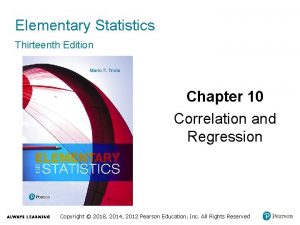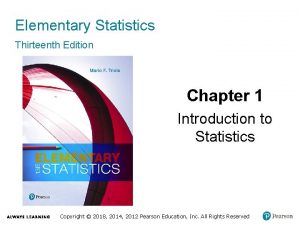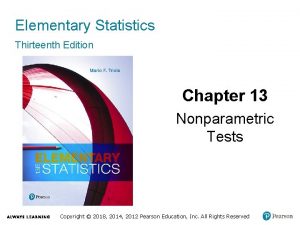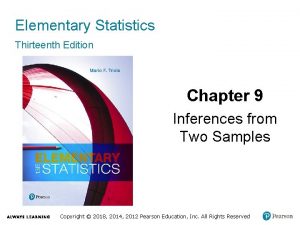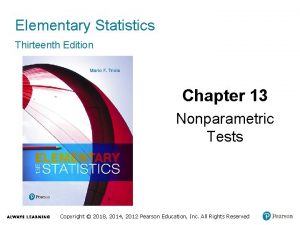Elementary Statistics Thirteenth Edition Chapter 7 Estimating Parameters







































- Slides: 39

Elementary Statistics Thirteenth Edition Chapter 7 Estimating Parameters and Determining Sample Sizes Copyright © 2018, 2014, 2012 Pearson Education, Inc. All Rights Reserved

Estimating Parameters and Determining Sample Sizes 7 -1 Estimating a Population Proportion 7 -2 Estimating a Population Mean 7 -3 Estimating a Population Standard Deviation or Variance 7 -4 Bootstrapping: Using Technology for Estimates Copyright © 2018, 2014, 2012 Pearson Education, Inc. All Rights Reserved

Key Concept (1 of 2) Copyright © 2018, 2014, 2012 Pearson Education, Inc. All Rights Reserved

Key Concept (2 of 2) There are three main concepts included in this section: • Confidence Interval: Use sample data to construct and interpret a confidence interval estimate of the true value of a population mean µ. • Sample Size: Find the sample size necessary to estimate a population mean. Copyright © 2018, 2014, 2012 Pearson Education, Inc. All Rights Reserved

Confidence Interval for Estimating a Population Mean with σ Not Known: Objective Construct a confidence interval used to estimate a population mean. Copyright © 2018, 2014, 2012 Pearson Education, Inc. All Rights Reserved

Confidence Interval for Estimating a Population Mean with σ Not Known: Notation µ = population mean n = number of sample values E = margin of error s = sample standard deviation Copyright © 2018, 2014, 2012 Pearson Education, Inc. All Rights Reserved

Confidence Interval for Estimating a Population Mean with σ Not Known: Requirements 1. The sample is a simple random sample. 2. Either or both of these conditions are satisfied: The population is normally distributed or n > 30. Copyright © 2018, 2014, 2012 Pearson Education, Inc. All Rights Reserved

Confidence Interval for Estimating a Population Mean with σ Not Known: Confidence Interval (1 of 2) Margin of Error: Confidence Interval: The confidence interval is associated with a confidence level, such as 0. 95 (or 95%), and α is the complement of the confidence level. For a 0. 95 (or 95%) confidence level, α = 0. 05. Copyright © 2018, 2014, 2012 Pearson Education, Inc. All Rights Reserved

Confidence Interval for Estimating a Population Mean with σ Not Known: Confidence Interval (2 of 2) Degrees of Freedom: df = n − 1 is the number of degrees of freedom used when finding the critical value. Copyright © 2018, 2014, 2012 Pearson Education, Inc. All Rights Reserved

Confidence Interval for Estimating a Population Mean with σ Not Known: Round-Off Rule 1. Original Data: When using an original set of data values, round the confidence interval limits to one more decimal place than is used for the original set of data. 2. Summary Statistics: When using the summary statistics of n, x, and s, round the confidence interval limits to the same number of decimal places used for the sample mean. Copyright © 2018, 2014, 2012 Pearson Education, Inc. All Rights Reserved

Key Points about the Student t Distribution (1 of 5) • Student t Distribution If a population has a normal distribution, then the distribution of is a Student t distribution for all samples of size n. A Student t distribution is commonly referred to as a t distribution. Copyright © 2018, 2014, 2012 Pearson Education, Inc. All Rights Reserved

Key Points about the Student t Distribution (2 of 5) In general, the number of degrees of freedom for a collection of sample data is the number of sample values that can vary after certain restrictions have been imposed on all data values. For the methods of this section, the number of degrees of freedom is the sample size minus 1. Degrees of freedom = n − 1 Copyright © 2018, 2014, 2012 Pearson Education, Inc. All Rights Reserved

Key Points about the Student t Distribution (3 of 5) Copyright © 2018, 2014, 2012 Pearson Education, Inc. All Rights Reserved

Key Points about the Student t Distribution (4 of 5) • The Student t distribution is different for different sample sizes. See the figure for the cases n = 3 and n = 12. The Student t distribution has the same general shape and symmetry as the standard normal distribution, but it has the greater variability that is expected with small samples. Copyright © 2018, 2014, 2012 Pearson Education, Inc. All Rights Reserved

Key Points about the Student t Distribution (5 of 5) • The Student t distribution has the same general symmetric bell shape as the standard normal distribution, but has more variability (with wider distributions), as we expect with small samples. • The Student t distribution has a mean of t = 0 (just as the standard normal distribution has a mean of z = 0). • The standard deviation of the Student t distribution varies with the sample size, but it is greater than 1 (unlike the standard normal distribution, which has s = 1). • As the sample size n gets larger, the Student t distribution gets closer to the standard normal distribution. Copyright © 2018, 2014, 2012 Pearson Education, Inc. All Rights Reserved

Procedure for Constructing a Confidence Interval for µ (1 of 2) 1. Verify that the two requirements are satisfied: The sample is a simple random sample and the population is normally distributed or n > 30. Copyright © 2018, 2014, 2012 Pearson Education, Inc. All Rights Reserved

Procedure for Constructing a Confidence Interval for µ (2 of 2) Copyright © 2018, 2014, 2012 Pearson Education, Inc. All Rights Reserved

Example: Finding a Critical Value t alpha by 2 (1 of 4) Copyright © 2018, 2014, 2012 Pearson Education, Inc. All Rights Reserved

Example: Finding a Critical Value t alpha by 2 (2 of 4) Solution Because n = 15, the number of degrees of freedom is n − 1 = 14. The 95% confidence level corresponds to σ = 0. 05, so there is an area of 0. 025 in each of the two tails of the t distribution, as shown. Copyright © 2018, 2014, 2012 Pearson Education, Inc. All Rights Reserved

Example: Finding a Critical Value t alpha by 2 (3 of 4) Copyright © 2018, 2014, 2012 Pearson Education, Inc. All Rights Reserved

Example: Finding a Critical Value t alpha by 2 (4 of 4) Solution Using Table A-3 To find the critical value using Table A-3, use the column with 0. 05 for the “Area in Two Tails” (or use the same column with 0. 025 for the “Area in One Tail”). Copyright © 2018, 2014, 2012 Pearson Education, Inc. All Rights Reserved

Finding a Point Estimate and Margin of Error E from a Confidence Interval Point estimate of µ: Margin of error: Copyright © 2018, 2014, 2012 Pearson Education, Inc. All Rights Reserved

Finding the Sample Size Required to Estimate a Population Mean: Objective Determine the sample size n required to estimate the value of a population mean µ. Copyright © 2018, 2014, 2012 Pearson Education, Inc. All Rights Reserved

Finding the Sample Size Required to Estimate a Population Mean: Notation µ = population mean σ = population standard deviation Copyright © 2018, 2014, 2012 Pearson Education, Inc. All Rights Reserved

Finding the Sample Size Required to Estimate a Population Mean: Requirement The sample must be a simple random sample. Copyright © 2018, 2014, 2012 Pearson Education, Inc. All Rights Reserved

Finding the Sample Size Required to Estimate a Population Mean: Sample Size The required sample size is found by Copyright © 2018, 2014, 2012 Pearson Education, Inc. All Rights Reserved

Finding the Sample Size Required to Estimate a Population Mean: Round-Off Rule If the computed sample size n is not a whole number, round the value of n up to the next larger whole number. Copyright © 2018, 2014, 2012 Pearson Education, Inc. All Rights Reserved

Dealing with Unknown σ When Finding Sample Size 1. Use the range rule of thumb to estimate the standard deviation as follows: σ range/4, where the range is determined from sample data. 2. Start the sample collection process without knowing σ and, using the first several values, calculate the sample standard deviation s and use it in place of σ. The estimated value of σ can then be improved as more sample data are obtained, and the sample size can be refined accordingly. 3. Estimate the value of σ by using the results of some other earlier study. Copyright © 2018, 2014, 2012 Pearson Education, Inc. All Rights Reserved

Example: IQ Scores of Statistics Students (1 of 3) Assume that we want to estimate the mean IQ score for the population of statistics students. How many statistics students must be randomly selected for IQ tests if we want 95% confidence that the sample mean is within 3 IQ points of the population mean? Copyright © 2018, 2014, 2012 Pearson Education, Inc. All Rights Reserved

Example: IQ Scores of Statistics Students (2 of 3) Solution Copyright © 2018, 2014, 2012 Pearson Education, Inc. All Rights Reserved

Example: IQ Scores of Statistics Students (3 of 3) Interpretation Among the thousands of statistics students, we need to obtain a simple random sample of at least 97 of their IQ scores. Copyright © 2018, 2014, 2012 Pearson Education, Inc. All Rights Reserved

Estimating a Population Mean When σ Is Known If we somehow do know the value of s, the confidence interval is constructed using the standard normal distribution instead of the Student t distribution, so the same procedure can be used with this margin of error: Copyright © 2018, 2014, 2012 Pearson Education, Inc. All Rights Reserved

Example: Confidence Interval Estimate of µ with Known σ (1 of 6) Copyright © 2018, 2014, 2012 Pearson Education, Inc. All Rights Reserved

Example: Confidence Interval Estimate of µ with Known σ (2 of 6) Solution Requirement Check: (1) The sample is a simple random sample. (2) Because the sample size is n = 15, the requirement that “the population is normally distributed or the sample size is greater than 30” can be satisfied only if the sample data appear to be from a normally distributed population, so we need to investigate normality. Copyright © 2018, 2014, 2012 Pearson Education, Inc. All Rights Reserved

Example: Confidence Interval Estimate of µ with Known σ (3 of 6) Solution Sample data appear to be from a normally distributed population. Copyright © 2018, 2014, 2012 Pearson Education, Inc. All Rights Reserved

Example: Confidence Interval Estimate of µ with Known σ (4 of 6) Solution Copyright © 2018, 2014, 2012 Pearson Education, Inc. All Rights Reserved

Example: Confidence Interval Estimate of µ with Known σ (5 of 6) Solution Copyright © 2018, 2014, 2012 Pearson Education, Inc. All Rights Reserved

Example: Confidence Interval Estimate of µ with Known σ (6 of 6) Solution Remember, this example illustrates the situation in which the population standard deviation σ is known, which is rare. The more realistic situation with σ unknown is considered in Part 1 of this section. Copyright © 2018, 2014, 2012 Pearson Education, Inc. All Rights Reserved

Choosing an Appropriate Distribution Choosing between Student t and z (Normal) Distributions Conditions Method σ not known and normally distributed population or σ not known and n > 30 Use student t distribution σ known and normally distributed population or σ known and n > 30 (In reality, σ is rarely known. ) Use normal (z) distribution. Population is not normally distributed and n ≤ 30. Use the bootstrapping method (Section 7 -4) or a nonparametric method. Copyright © 2018, 2014, 2012 Pearson Education, Inc. All Rights Reserved
 Elementary statistics 13th edition chapter 1
Elementary statistics 13th edition chapter 1 Elementary statistics 13th edition answers
Elementary statistics 13th edition answers Picturing distributions with graphs
Picturing distributions with graphs Elementary statistics 6th edition
Elementary statistics 6th edition Elementary statistics picturing the world 6th edition
Elementary statistics picturing the world 6th edition Elementary statistics tenth edition
Elementary statistics tenth edition Elementary statistics picturing the world 6th edition
Elementary statistics picturing the world 6th edition Elementary statistics 13th edition
Elementary statistics 13th edition What is the point estimate of μ?
What is the point estimate of μ? 5% guideline for cumbersome calculations
5% guideline for cumbersome calculations Elementary statistics chapter 3
Elementary statistics chapter 3 Elementary statistics chapter 3
Elementary statistics chapter 3 Elementary statistics larson farber
Elementary statistics larson farber Elementary statistics chapter 6
Elementary statistics chapter 6 Elementary statistics chapter 4
Elementary statistics chapter 4 What is a margin of error
What is a margin of error Elementary statistics chapter 4
Elementary statistics chapter 4 Elementary statistics chapter 2
Elementary statistics chapter 2 What are parameters in statistics
What are parameters in statistics Elementary and middle school mathematics 10th edition
Elementary and middle school mathematics 10th edition Elementary statistics william navidi pdf
Elementary statistics william navidi pdf Introduction to elementary statistics
Introduction to elementary statistics William navidi essential statistics pdf
William navidi essential statistics pdf William navidi essential statistics pdf
William navidi essential statistics pdf William navidi essential statistics pdf
William navidi essential statistics pdf Using mis (10th edition) 10th edition
Using mis (10th edition) 10th edition Report
Report Statistics informed decisions using data 5th edition pdf
Statistics informed decisions using data 5th edition pdf Basic business statistics 12th edition
Basic business statistics 12th edition Statistics: unlocking the power of data 1st edition
Statistics: unlocking the power of data 1st edition Dr ruth yates
Dr ruth yates Introduction to statistics what is statistics
Introduction to statistics what is statistics Chapter 8 estimating with confidence
Chapter 8 estimating with confidence Suppose your class is investigating the weights of snickers
Suppose your class is investigating the weights of snickers Chapter 8 estimating with confidence
Chapter 8 estimating with confidence Voyage estimating decision support system
Voyage estimating decision support system Rounding and estimating
Rounding and estimating Mcaces
Mcaces Estimation of degradation function
Estimation of degradation function Gao cost estimating guide
Gao cost estimating guide
